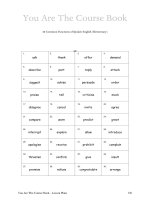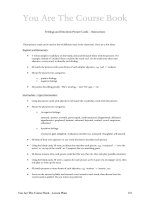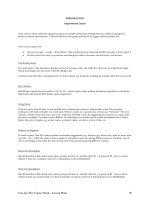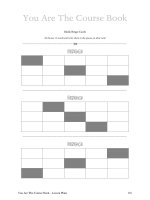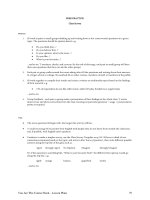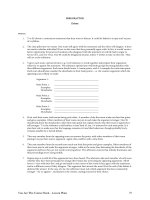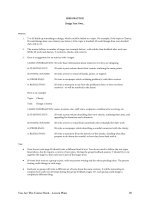yatcb lesson plans verb forms revision q and a
Bạn đang xem bản rút gọn của tài liệu. Xem và tải ngay bản đầy đủ của tài liệu tại đây (42.31 KB, 1 trang )
Verb Forms Revision
Q&A
Method:
1.
T asks SS to suggest some content words connected with a given topic. T selects the most interesting and
writes 4-6 words on the board.
2.
T asks SS: “Can you think of a word that goes well (collocates) with each word?” then selects the best
answers and writes them either before or after the words.
3.
T asks SS: “Choose two tenses that you want to practice.” T writes them on the board, then elicits the
auxiliary verb(s) and time in each one, e.g.
tense:
present simple
present continuous
auxiliary verb(s):
do / does
am / is / are
time:
regular time
now or future (with a time phrase)
SS could use the verb forms revision sheet on p.121 to help them. Or, T could choose the tenses that they
want to practice with the SS, e.g. linked to a syllabus. T elicits the various functions of each tense, with
examples of use.
4.
T models the activity with the whole class, by saying a sentence in the first tense using one of the
collocations and asking SS repeat it. Then T chooses a SS to say the sentence. T corrects and SS repeats the
sentence correctly, if wrong first time. T asks the SS questions based on the sentence, e.g. if the sentence is:
“I go for a walk by the river every morning.”
T could ask several different questions, e.g.
Where do you go every morning?
What do you do every morning?
When...? How often? Do you...?
...and so on. Then T says the original sentence and the SS has to make the question forms. T elicits
corrections from the other SS if they make errors.
5.
Optional: T could repeat this activity with a different SS using the same collocation.
6.
Next, SS work in pairs with a new sentence that has a different collocation and/or tense; then group
feedback. T chooses different pairs to present their dialogues, eliciting correction of errors where
necessary.
7.
Then SS work in their pairs and repeat the activity using different collocations in both tenses. T allows a
short period for this, e.g. 10 mins. T monitors, checks, and corrects.
8.
Group feedback: T asks different pairs to present their dialogues, eliciting correction of errors where
necessary.
Tips:
•
T could ask two of the stronger SS to model the activity with the tenses with the first collocation, rather
than T doing it.
•
T can vary the length of this activity: to make it shorter, use fewer collocations and only one tense; to
make it longer, use more collocations and more tenses.
You Are The Course Book – Lesson Plans
66
